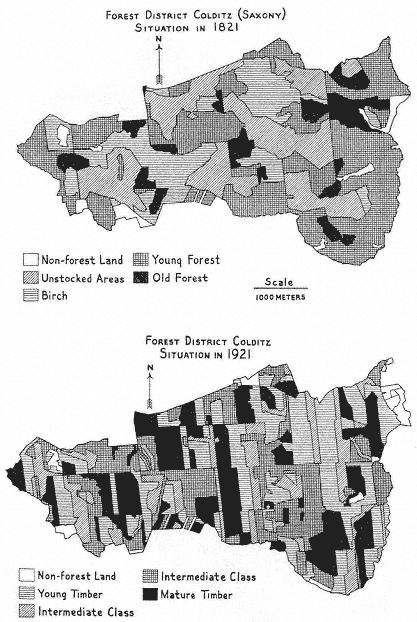7
The Measure of Enlightenment
By J.L. Heilbron
The quantifying spirit united with the purposes of the Enlightenment and the Revolution to produce the metric system of weights and measures. This exemplar of 18th-century rationalism was directed against the foggy and feudal metrology of the Ancien Régime; supported by the rhetoric of the philosophes ; realized through the politics of scientific societies and revolutionary tribunals; and resisted by the common man in whose interest the reformers, philosophes , scientists, and revolutionaries claimed to act.
The Plight of the People
Cain's Legacy
God may have made the world according to weight and measure, but it was Cain who invented weights and measures, and thus—we have this from Flavius Josephus—"converted the innocent simplicity in which man had lived into a miserable existence dominated by fraud and deceit."[1] The existence of French men and women around 1790 was made miserable by, among other things, 700 or 800 differently named measures and untold units of the same name but different sizes. A "pinte" in Paris came to 0.93 liter; in Saint-Denis, to 1.46; in Seine-en-Montagne, to 1.99; in Précy-sous-Thil, to 3.33. The aune, a unit of length, was still more prolific: Paris had three,
The following abbreviations are used in the notes: HAS and MAS , Académie des sciences (Paris), Histoire and Mémoires , resp.
[1] Josephus, Jewish antiquities , cited by Witold Kula, Measures and men (Princeton: Princeton University Press, 1986), 3.
each for a different sort of cloth; Rouen had two; and France as a whole no fewer than seventeen, all in common use and all different, the smallest amounting to just under 300 lignes, royal measure, the largest to almost 600.[2]
France possessed nonuniform measures in law as well as by custom. Their multiplicity went with other relics of the feudal system, which maintained arbitrary rents and duties usually to the disadvantage of the peasant. A landlord wanted his bushels of grain or hogsheads of beer in the biggest measures in use in the neighborhood, and he preferred to sell according to the smallest. Nor were all seigneurs above enlarging the vessel in which they collected their rents; and since in many cases they possessed the only exemplars of their patrimonial bushel, no one could be certain that it did not grow in time. But one suspected. A frequent complaint in the cahiers , or notebooks of desiderata brought by representatives of the people to the meeting of the Estates General in 1789, was that "the nobles' measure waxes larger year by year." These same representatives castigated the oppressive confusion of customary measures as barbaric, ridiculous, obscurantist, gothic, and revolting, and demanded an end to them, and the establishment of a system of unchanging and verifiable weights and measures throughout the country, or at least throughout their region. Many urged that the King's measure, the royal foot, be made the law of the land.[3]
Sharpers and crooks whose practices were not sanctioned by ancient rights and wrongs and middlemen acting in analogy to money changers opposed the rationalization that menaced their livelihood. In 1747, shortly after returning to Paris with the vision acquired while measuring a piece of a meridian in Peru, Charles-
[2] Georges Bouchard, Un Organisateur de la victoire. Prieur de la Côte-d'Or membre du Comité de salut publique (Paris: R. Clavreuil, 1946), 286; Charles Maurice de Talleyrand-Périgord, Proposition faite à l'Assemblée nationale, sur les poids et les mesures (Paris: Impr. nationale, 1790), in John Riggs Miller, Speeches in the House of Commons upon the equalization of the weights and measures of Great Britain. . .together with two letters from the Bishop of Autun (London: J. Debrett, 1790) 60–3.
[3] Kula, Measures and men , 164–226, esp. 191–6, 230, 236; Beatrice Fry Hyslop, French nationalism in 1789, according to the general cahiers (New York: Octagon, 1968), vii, 56.
Marie de La Condamine identified and condemned this special interest, which he proposed to abolish with the confusions that engendered it. His accusation echoed in France for decades and eventually bounced across the Channel. We read in the cahiers from Orléans that multitudinous measures "expose[d] people daily to swindlers" and in the records of Parliament that John Riggs Miller, an obscure and verbose M.P., declared that they had but one purpose, "the perplexing of all dealings, and the benefitting knaves and cheats."[4]
Reformers laid down several requirements for a new system of weights and measures. It should not rest on an arbitrary unit, especially not on a king's foot; it must not offer enticements to cheaters; and it had to be easily reproduceable were its exemplars lost. Further, it had to be rational, so as to recommend itself to all nations, and become universal. The measuring stick used by La Condamine and his colleagues, the "toise de Pérou," had attained some currency in France and in a few other countries, and the units used in Paris also had more than local authority. It would not do to impose them, however, as Talleyrand wrote Miller, since they had not been derived from nature or constructed "with the ceremony necessary to settle once and for all the opinion of all enlightened nations." Last and also first, the reformed system had to be simple, or, as Miller preferred to say, "on a level with the lowest and humblest capacity." It must not require "skill in calculation beyond what. . .the inferior orders of men commonly possess"; everyone should be able to confirm for himself the correctness of all transactions of interest to him, "the meanest intellect. . .on a par with the most dexterous."[5]
This last paragraph contains many buzz-words of the Englightenment.[6] The replacement of the arbitrary and the capricious, of the
[4] Charles-Marie de La Condamine, "Nouveau projet d'une mesure invariable, propre à servir de mesure commune à toutes les nations," MAS , 1747, 489-514, on 492–5; Kula, Measures and men , 209; Miller, in Thomas C. Hansard, Parliamentary history , 28, col. 322, and Miller, Speeches , 18.
[5] Talleyrand, Proposition , in Miller, Speeches , 68–9; Miller, ibid., 16, 35, and in Hansard, 28, col. 321.
[6] Cf. Maurice Crosland, "'Nature' and measurement in eighteenth century France," Studies on Voltaire and the eighteenth century, 87 (1972), 277–309, on 297.
feudal and historical, by the natural is the message of all the philosophes from Montesquieu to Condorcet. The natural coincides with the rational and the universal: when people cast aside customary belief and established abuse, they can reach agreements that all others, guided by their own reason, will accept. This reason is not the property of a few great intellects; the truth is accessible to all, or at least to every man. Everyone has the right to know, and to recognize, the truth. Any system that claims universal assent must be universally intelligible.
Mathematics and the Rights of Man
From the most remote times philosophers have taken number as the exemplar of the intelligible. Once one has grasped a principle in geometry, it was said, not even God Himself could understand it better, although, to be sure, He might know more theorems. Calculating people think for themselves; they despise the unintelligible, capricious, unfounded, authoritarian, and feudal as infringements on their thoughts and actions. In brief, mathematics is a science for free people. Or, to say the truth as the 18th century saw it, for free men. Newton's doctor, Sir John Arbuthnot, praised mathematics for giving "a manly vigour to the mind"; a tonic Newton took to such good effect that he mastered all "the noble and manly sciences" and became "the greatest man that ever liv'd."[7] All this will help to construe the remark made by the representatives of the revolutionary government in 1799, on accepting the prototypes of the meter, liter, and kilogram. The metric measurers, they said, reaching for their highest compliment, had carried through their work "with the confidence of a male and republican spirit."[8]
If mathematics is male, Europe grew increasingly manly during the 18th century. When Samuel Pepys became clerk of the king's ships in
[7] Quoted from, respectively, John Arbuthnot, Miscellaneous works , 2 vols. (Glasgow: J. Carlisle, 1751), 1, 9, 36, and James Jurin, in Royal Society of London, Philosophical transactions, 34 (1727), dedicatory epistle to Martin Folkes.
[8] P.L.C. Baudin, 4 messidor an VII (19 June 1799), in P.F.A. Méchain and J.B.J. Delambre, Base du système métrique decimal, ou Mesure de l'arc du méridien compris entre les parallèles de Dunkerque et Barcelone , 3 vols. (Paris: Baudoin, 1806–10), 3, 650.
1660, he had to recruit his strength (he was then 27) and repair his education (which was excellent) by learning the multiplication table. In the resulting fit of machismo , he forced his wife to learn arithmetic.[9] Most of learned Europe in the 17th century was "innumerate," if by analogy to "literacy" we take "numeracy" to mean familiarity with numbers. During the 18th century the requirements of government bureaucracies, commerce, colonization, mining, rational agriculture, forest management, the military, and so on, brought dramatic increases in numeracy. Before 1750 Poor Richard enjoins us in rhymes to go early to bed to secure health, wealth, and wisdom; just after 1800 a book called The young man's guide delivers the same message by multiplication. If you stay up to eleven o'clock every night, the Guide admonishes, in fifty years you will uselessly expend $182.50 on candles.[10]
Perhaps the most significant sign of this burgeoning rudimentary numeracy was the multiplication of tables of numerical equivalence. A good survey of the tables in use in commerce has yet to be made; but there is no doubt that their number increased dramatically after the Seven Years' War. They came in several sorts: conversions of weights, measures, and moneys; total cost of goods, tabulated by size and unit cost; tables of interest and annuities; agricultural yields; and so on. It did not require great prowess at mathematics to use these compilations; rather, a degree of numeracy comparable to the literacy of one who could read but not write. The spread of the metric system depended on this widespread rudimentary numeracy, and raised its level.
These tables were required not only because of the number and uncertain equivalence of feudal weights and measures, but also, and
[9] Samuel Pepys, Diary , ed. Robert Latham and William Matthews, 11 vols. (Berkeley: University of California Press, 1970–83), 3, 134, quoted by Patricia Cline Cohen, A calculating people. The spread of numeracy in early America (Chicago: University of Chicago Press, 1982), 26; Helen M. Wallis, "Geographie is better than Divinitie: Maps, globes, and geography in the days of Samuel Pepys," in Norman J.W. Thrower, ed., The compleat platt-maker. Essays on chart, map, and globemaking in England in the seventeenth and eighteenth centuries (Berkeley: University of California Press, 1978), 1–43, on 2, 6. Cf. Pepys, Diary , 3, 131, 135, 137.
[10] Cohen, Calculating people , 110–3.
perhaps primarily, because the arbitrary multiples and submultiples of the various units made computation burdensome and complex. Calculation of the price of a piece of cloth 2 yards 1 foot 4 inches square at 3 pence 2 farthings the square foot was a sufficient challenge. To change it into aunes, pieds, livres, and deniers, and to proceed to a problem in bushels and cubic king's feet, would have puzzled Archimedes. According to the Paris Academy, referring to the situation in 1790, people at ease with money computations could not handle weights and measures. "In the present state of affairs, a man who can calculate with sous and deniers cannot calculate with toises, pieds, pouces, and lignes, with livres, onces, gros and grains."[11]
The Paris Academy and many other scientific reformers supposed that by dividing the new standards and the revised coinage decimally they would eliminate the need for specialist computers. The decimal was not free from arbitrariness; but its simplicity and convenience could not be gainsaid, at least by practiced calculators, and, as the Academy observed, although not universal it is as natural as the human hand.[12] Only the hand of the learned had so far employed decimal arithmetic, and by no means universally, as Lavoisier pointed out in his Elements of chemistry , when urging his colleagues to state weights in decimal parts of whatever units they used. This natural arithmetic, "previously locked up in the domain of the sciences," was precisely what the reformers thought they sought. "Those who knew little will know everything; others will hurry to forget what they no longer need to know; all will accept as a true benefit a method of calculation that will save them time, study, and chances for error."[13]
Prieur de la Côte d'Or, a former military engineer who served on the all-powerful Committee of Public Safety (Comité du salut public), expected the decimal calculus to be the technical language of Utopia.
[11] Charles Borda, J.L. Lagrange, A.L. Lavoisier, Matthieu Tillet, and M.J.A.N. Caritat, marquis de Condorcet, "Rapport" (27 Oct 1790), HAS , 1788, 1–6, on 5.
[12] Ibid., 6; cf. Crosland, "'Nature' and measurement," 299.
[13] France, Commission temporaire des poids et mesures republicaines, Instruction abrégée sur les mesures deduites de la grandeur de la terre, uniformes pour toute le République, et sur les calculs relatifs à leur division décimale (Paris: Impr. nationale exécutive du Louvre, an II), xvii, 171a; Antoine Laurent Lavoisier, Elements of chemistry (Edinburgh: William Creech, 1790), 295–6.
"How happy we will be not to be forced to consult anyone about our prosperity, property, expenses, and drink, and to have nothing to do any more with people who often seek only to profit from our ignorance."[14] The connection between democracy and the decimal was made plain and explicit by Condorcet during the first year of the Revolution. Decimalization, he said, fit perfectly with the political program and mandate of the National Assembly. "It [the Assembly] wants to insure that in the future all citizens can be self-sufficient in all calculations related to their interests; without which they can be neither really equal in rights. . .nor really free."[15] Long after the promulgation of the metric system, Laplace advised Napoleon that its chief advantage as understood by its creators was not the destruction of feudal metrology but the division by tens.[16]
Republican zeal is not easy to curb, and the decimalization of everything measured or metered figured among the excesses of the French Revolution. The Paris academicians demonstrated solidarity with the regime by dividing a right angle into 100 revolutionary degrees, and each such degree into 100 minutes; and they found much pleasant recreation in recomputing the trigonometrical functions in what Jean-Baptiste Joseph Delambre, the most assiduous of the metric measurers, later extolled as "the vastest [calculation] that had ever been done, or even conceived." The innovation neither saved the Academy nor suppressed the reckoning of the Babylonians, with which it still coexists in France. A less enduring initiative, the revolutionary calendar, which came into operation retrospectively on the day of the autumnal equinox of 1792, divided the year into twelve parts of thirty days each, grouped in ten-day blocks. The five
[14] C.A. Prieur, Instruction sur le calcul décimal, appliqué principalement au nouveau système des poids et mesures (Paris: Impr. de la République, germinal an III [1795]), 4–5; cf. Miller, Speeches , 39.
[15] Condorcet, Mémoires sur les monnoies (Paris, 1790), 3–4, quoted in Ruth Inez Champagne, The role of five eighteenth-century French mathematicians in the development of the metric system (Ph.D. dissertation, Columbia University, New York, 1979), 60.
[16] Text of 7 May 1811, in G. Bigourdan, Le système métrique des poids et mesures. Son établissment et sa propagation graduelle (Paris: Gauthier-Villars, 1901), 193.
or six additional days required to make up the year were intercalated as necessary.[17]
The unsystematic concession to lunar motions represented by the numbers 12 and 3 in the divisions of the revolutionary year was offset by a revolutionary day of ten "hours," each containing 100 "minutes" and 10,000 "seconds." Several clocks ticking 10,000 "seconds" a day were made, but most clock makers and watchers preferred to divide their time in the manner of the servile peoples of Europe. On 18 germinal an III (7 April 1795), the revolutionary government suspended republican time sine die on the official ground that it was of interest only to scientists. The calendar survived longer, until 1 January 1806, when Napoleon put an end to it.[18]
The cost of conversion to decimal units was borne by the people whose lives the system was intended to ease. In computing prices of old goods in the new currency, sellers naturally rounded up to their advantage. The common man as naturally opposed the change. So did the common woman. According to a squib of 1791, the prostitutes of the Palais Royal, whose rates had been recomputed, complained that the 100 sols they now received for their services devalued their charms, "which opinion had previously reckoned at an écu and six livres," by a sixth.[19] It is not easy to anticipate the effects of reform.
Another conflict between geometry and system arose in the naming of the decimal divisions of the meter. In 1792 the Academy discussed the relative advantages of system (in which divisions would be
[17] Exposition abrégée du nouveau systême des poids et mesures, d'après le mètre définitif (Avignon: Seguin, an X), 13–4; J.B.J. Delambre, Rapport historique sur les progrès des sciences mathématiques depuis 1789, et sur leur état actuel (Paris: Impr. impériale, 1810), 8; L. Rondonneau, Concordance des calendriers républicain et grégorien , 6th ed. (Paris: Rondonneau and Decle, 1812), v–vii; Georges Villain, "Etude sur le calendrier républicain," La Révolution française , 7 (1884), 451–9, 535–53 and 8 (1885), 623–56, 740–58, 830–54, 883–8.
[18] France, Commission temporaire des poids et mesures républicains, Instruction , 33–4, and Avis (Paris: Impr. de la République, frimaire an IV [1795]), 8; Bouchard, Prieur , 308–10; Thomas Bugge, Science in France in the revolutionary era , ed. M.P. Crosland (Cambridge, Mass.: MIT Press, 1969), 203–4; Rondonneau, Concordance , xii–xiv; Villain, "Calendrier républicain," 885–8.
[19] Bouchard, Prieur , 310–1.
designated by the prefixes "deci-," "centi-," "milli-," and the only multiple would be "milliaire") and familiarity (in which submultiples of the meter would have common names, like "palme" and "doigt"), and plumped for the familiar. They erred in calculating revolutionary zeal. The Committee on Public Instruction (Comité d'instruction publique) preferred a clean sweep and adopted the systematic names. This occurred on 1 August 1793, on the eve of the suppression of the Academy.[20] One of the Academy's successors in metric matters explained that "it is almost impossible to reason correctly without a language aptly made."[21]
The language did not please the people. Classicists objected that the prefixes (enriched by "déca-," "hecta-," and "kilo-") violated the grammar of ancient languages, while the uneducated could make no sense of them at all. "These names," declared a delegate to the Convention, "novel and unintelligible to the large majority of our citizens, are not necessary for the maintenance of the Republic."[22] He did not know what he had escaped. Prieur de la Côte d'Or, who had taken an active part in the reform of weights and measures from the onset of the Revolution, had names of his own, derived, he said, from ancient languages and Low Breton. The irrationality of the Convention did not extend to adopting "kilicymbe," "myriadore," "ladedix," "pèzeprime," "centicadil," or "decidol," and Prieur, bending to the political wind in 1795, drew up what became the definitive metric names. The many centicadils of bitterness he then swallowed and decidols of crow he then ate were to damage the work of the metric reformers.[23] All concerned might have spared themselves the trouble. For decades the people stubbornly opposed decimalized units and their jabberwocky names.
[20] HAS , 1789, 1–18 (text of 1792); Bigourdan, Système métrique , 78–82.
[21] France, Agence temporaire des poids et measures, Aux citoyens redacteurs de la feuille du Cultivateur, en réponse à des objections contre la nomenclature nouvelle, inserées dans le No. 38 de ce journal (Paris: Impr. de la République, thermidor an III [1795]), 10.
[22] Bigourdan, Système métrique , 82 (text of 11 Aug 1795).
[23] Bouchard, Prieur , 297–9; J.B.J. Delambre, Grandeur et figure de la terre , ed. G. Bigourdan (Paris: Gauthier-Villars, 1912), 212.
The Program of the Academy
Professional Imperatives
By 1789 the French had made three measurements of arcs along the meridian passing through Paris. The earliest, made by Jean Picard between 1668 and 1670, on an arc of about 1°20', gave a value for the length of a degree of latitude near Paris that differed by less than three parts in ten thousand from what the metric measurers later obtained with much greater labor and much better instruments.[24] The second arc, extending over 8°30' from Dunkirk to Perpignan and completed under Jacques Cassini in 1718, authorized a new Atlantic coastline that brought some French towns a hundred or more kilometers East of their previous positions. Louis XV lost more land to his cartographers than his successors have to the Germans. The measurements were not accurate enough, however, to settle the much agitated question of the shape of the earth. In the 1730s, the Paris Academy sent out its expeditions to Peru and to Lapland to measure arcs far enough apart to reveal the departure of the earth's profile from perfect sphericity. Their results, which confirmed Newton's conclusion that mechanics required the equatorial axis to exceed the polar, agreed with the third measurement along the Paris meridian, made during 1739 and 1740 by the Abbé Nicolas-Louis de Lacaille.[25]
As the general shape of the earth came into view, its finer features loomed ever larger in academic minds. Lacaille contributed another data point by measuring an arc at the Cape of Good Hope. The Pope, the Austrian-Hungarian Empress, and the King of Sardinia commissioned surveys of meridians traversing their domains, with the consequence, as one of the surveyors put it, that the more the earth
[24] Jean Picard, Mesure de la terre (Paris: Impr. royale, 1671); republished in MAS , 1666–99, 7, 133–90, and in P.L. Moreau de Maupertuis et al., Degré du méridien entre Paris et Amiens déterminé par la mesure de M. Picard (Paris: Martin, Coignar, and Guerin, 1740), 1–106. Picard gives 57,060 toises (fathoms) per degree, which was nominally 15 toises off the definitive value. In fact, the difference came to about 30 toises when Picard's measurements were corrected for refraction and a small error in his baseline; see Méchain and Delambre, Base, 1 , 7–8.
[25] Delambre, Grandeur , 63–72.
was measured, the more uncertain its shape became.[26] The British then ran an arc through Greenwich, to serve as the backbone for a military map of Scotland. The Paris academicians looked upon it rather as an opportunity to improve geodesy, and in 1783 they proposed a linking of the Paris and Greenwich observatories by triangles based on the meridians already determined. The proposal had a sporting side. The linking would pit the small repeating circle then recently invented by Charles Borda, a prominent academician and a former naval officer, against the large theodolite built by the world's leading instrument-maker, Jesse Ramsden, for the triangulations in England.[27]
Jean Dominique Cassini (Cassini IV), who took nominal charge of the French party, retrospectively threw down the challenge: "we dared to flatter ourselves that we had on our side an instrument that yielded nothing to the English in point of precision." The showdown took place in the late summer of 1787. The British turned their great theodolite toward Calais; the French aimed their delicate circle at Dover. The British took their single observations quickly; the French multiplied their repetitions slowly. The season grew late. Fog descended. The weather did not remit long enough to permit the full circle of French measurements, and the contest between the repeater and the theodolite ended indecisively.[28] As Delambre wrote much later, however, "a more important occasion soon presented itself to demonstrate the advantages of the new instrument."[29]
[26] R.J. Boscovich and Christoph Maire, Voyage astronomique et géographique dans l'Etat de l'Eglise: Entrepris par l'ordre at sous les auspices du pape Benôit XIV (Paris: Tilliard, 1770), 492, cited in Djordje Nikolic, "Roger Boskovic et la géodésie moderne," Archives internationales d'histoire des sciences, 14 (1961), 315–35, on 315.
[27] Jean Mascart, La vie et les travaux du chevalier Jean-Charles de Borda (1733–1799) (Lyon: A. Rey; Paris: A. Picard, 1919), 370–1, 381–3, 488–9, 501–2. Cf. S. Widmalm, chap. 6 in this volume.
[28] J.D. Cassini, "De la jonction des observatoires de Paris et de Greenwich, et précis des travaux géographiques exécutés en France, qui y ont donné lieu," MAS , 1788, 706–17, on 710–3.
[29] J.B.J. Delambre, Histoire de l'astronomie au dix-huitième siècle (Paris: Bachelier, 1827), 758.
Institutional Considerations
In exchange for their salaries, status, and grants for special projects like geodetic surveys, the Paris academicians acted as technical advisers to the Crown. Their advice tended to be conservative and elitist, especially in respect of unsolicited proposals from inventors asking for state subventions or monopolies for their novelties. Experience confirmed what arrogance had suspected: most of the proposals were worthless and most of the proposers ignorant. The Academy suggested that artisans might be licensed, but only after passing an examination in geometry and other useful arts. During the Revolution, the Academy faced the hostility directed at all enclaves of privilege and the special anger of frustrated inventors, manufacturers, and would-be scientists who had suffered at its hands.[30]
Well into 1790 the Academy held its meetings, read papers, and planned projects as usual. Some academicians favored the new regime, but few wished it to further; almost all lamented the disturbances that kept them from their work. Many recognized, however, that they would have to reorganize their company in keeping with the new style, especially after the establishment in 1791 of a patent law that took from them their chief public service.[31] As a partial offset, academicians became increasingly involved in government technical projects. Of these, the most important, "repeatedly paraded as a prime example of science's potential value to the nation and a concrete instance of the Academy's proper function in society," was the reform of weights and measures.[32]
[30] C.C. Gillispie, Science and polity in France at the end of the ancien régime (Princeton: Princeton University Press, 1980), 97–9, 461–3; Roger Hahn, The anatomy of a scientific institution. The Paris Academy of sciences, 1666–1803 (Berkeley: University of California Press, 1971), 118–21; Gillispie, "The Encyclopédie and the Jacobin philosophy of science: A study in ideas and consequences," in Marshall Clagett, ed., Critical problems in history of science (Madison: University of Wisconsin Press, 1959), 255–89, on 257, 268–74.
[31] C.P. Molard, Description des machines et procédés spécifiés dans les brevets d'invention, de perfectionnement et d'importation, dont la dureé est expiré (Paris: Huzard, 1811), 7–27; Hahn, Anatomy , 186–9; Henry Guerlac, Essays and papers in the history of modern science (Baltimore: Johns Hopkins University Press, 1977), 467–8.
[32] Hahn, Anatomy , 162–3.
A month after the storming of the Bastille, academician Jean Baptiste Le Roy, physicist, mathematician, and one-time clockmaker, suggested that the Academy propose to the National Assembly a dissolution of the over-rich metrological heritage of the Republic. The proposal, probably drawn up by the Academy's secretary, the marquis de Condorcet, and certainly presented to the Assembly by Talleyrand, set aside all existing units in favor of the length of a pendulum that beat seconds at the 45th parallel of latitude, which passes just north of Bordeaux. Talleyrand proposed further that the British be invited to join in the determination and in promoting the result, "so that all nations might adopt it."[33]
On 8 May 1790 the Assembly considered the Talleyrand or Academy proposal together with several others to the same effect, notably one by Prieur, who expressly opposed using an arc of the meridian as a basis. "Besides the magnitude of the fundamental operation required, the difficulty of verifying it, and the impossibility of doing so daily, it is not easy to decide how exact the method might be." Here Prieur spoke as a military engineer familiar with surveying practice and with the lingering uncertainties over the earlier measurements of arcs. The same considerations caused Thomas Jefferson to give up his project of taking a decimal part of Cassini's degree as the basis of a new American unit: "the various trials to measure various portions of [meridians], have been of such various result, as to show there is no dependence on that operation for certainty."[34]
The seconds pendulum had been proposed as a standard-setter for over a century. The pioneer geodecists preferred it: Picard, in 1671, proposed defining the pied as a third, and the toise as twice, the length of the seconds pendulum at a convenient place; Jacques Cassini observed that all domestic measures could usefully be referred to
[33] Hahn, Anatomy , 163–4; Bigourdan, Système métrique , 14–5; Talleyrand in Miller, Speeches , 59.
[34] Bouchard, Prieur , 287–90; William David Pattison, Beginnings of the American rectangular land survey system, 1784–1800 (Chicago: University of Chicago Press, 1957), 48–9, after Jefferson, Papers , ed. Julian P. Boyd et al. (Princeton: Princeton University Press, 1950+), 7, 25, 150–60; Bigourdan, Système métrique , 10.
such a unit, and even all European measures, since the length of a seconds pendulum is about the same throughout the Continent; La Condamine proposed international cooperation and a pendulum regulated at the equator, as determined by himself and "the hands of nature"; and Turgot, as controller of finance under Louis XVI, almost initiated a nationwide reform based on the seconds pendulum at 45°.[35] Just before the Revolution, Gaspar de Prony, who would play an important part in the metrication of France, declared the pendulum to be the ultimate arbiter of length; and after the promulgation of the meter, a compiler of dictionaries, no doubt lifting from his predecessors, held that "the length of the simple pendulum, an invariable quantity always easy to recover, seemed given by nature to serve as a measure in all countries."[36] The British had also considered the advantages of Cassini's suggestion, and of calibrating their yard by the pendulum, in order that "all future generations [may] obtain similar measures of length, capacity, and weight, and thereby render it altogether needless to cut them on stone, or to engrave them on brass, to perpetuate their existence."[37]
Miller was about to introduce proposals for the reform of English weights and measures based on the pendulum when a letter from Talleyrand inviting Britain to join France in finding the length of a seconds pendulum came to hand. The plan was simple, and a natural successor to the linking of the observatories of Paris and Greenwich, "which all Europe would take as a guarantor of rigorous exactitude."[38] While Parliament pondered the opportunity, the Revolution became too hot for Anglo-Saxon reformers, and the Paris Academy removed the rationale for collaboration by deciding not to take the
[35] Bigourdan, Système métrique , 6–11; Jacques Cassini, De la grandeur et de la figure de la terre (Paris: Impr. royale, 1720), 250; La Condamine, "Nouveau project," 501–5, 511; Charles Henry, Correspondance inédite de Turgot et Condorcet (Paris: Charavay, 1883), xxv, 234–5.
[36] Gaspar de Prony, "Discours préliminaire," in William Roy, Description des moyens employés pour mesurer la base de Hounslow-Heath (Paris: Didot, 1787), xvi-xvii; Lunier, Dictionnaire des sciences et des arts , 3 vols. (Paris: Normant and Nicolle, 1806), 2, 615, s.v. "mesure."
[37] John Whitehurst, "An attempt toward obtaining invariable measures," in The works (London: W. Bent, 1792), iii (text of 1787); Miller, Speeches , 44.
[38] Talleyrand in Miller, Speeches , 71.
pendulum as primary. Its decision seemed odd to many.[39] The rationale must be sought, not in the requirements of measurement, but in the circumstances into which the Revolution propelled the Academy.
The National Assembly accepted Talleyrand's proposal and sent it and a question about the most useful division of weights, measures, and monies to the Academy, which referred both matters to a committee composed of Borda, Lagrange, Lavoisier, Tillet, and Condorcet. The committee reported on 27 October 1790 that everything should be decimal.[40] It then handed what remained of its charge to a committee consisting of Borda, Lagrange, Laplace, Monge, and Condorect. On 19 March 1791 these geometers reported that the pendulum was the poorer of the two universal and natural units they could imagine. They plumped instead for a piece of the Paris meridian and yet another measurement of it.
Their objections to the pendulum suggest a hidden agenda. In obtaining a length from pendulum beats, they wrote, a unit of time, which has nothing to do with distance, must be invoked; and this unit, the 86,400th part of a day, had the additional blemishes of being both arbitrary and nondecimal. "It is much more natural, in fact, to refer distances from one place to another [the academicians were thinking of a standard for cartography, not for commerce] to a quarter of a terrestrial circle rather than to the length of a pendulum." The committee did appreciate the greater convenience of the pendulum standard, for which they provided: the Academy would undertake to determine the length of a seconds pendulum at the Paris Observatory, to serve as a secondary reference, the primary to be one ten-millionth of the distance from pole to equator.[41]
[39] Hansard, 28 , cols. 315–17; Miller, Speeches , 43–4; George Evelyn Shuckburgh, "An account of some endeavors to ascertain a standard of weight and measure," Royal Society of London, Philosophical transactions, 88 (1798), 133–82, on 165–6.
[40] Borda, Lagrange, Lavoisier, et al., "Rapport," 1–6; Méchain and Delambre, Base, 1 , 14; Bigourdan, Système métrique , 16.
[41] Charles Borda, J.L. Lagrange, and Gaspard Monge, "Rapport. . .sur la systême général des poids et mesures," HAS , 1789, 1–18, on 1–6 (decimalization), 7–16 (arc over pendulum). Cf. Bigourdan, Système métrique , 17–8; Méchain and Delambre, Base, 1 , 14–9.
Although the ambition of the academicians did not extend to measuring the full quarter meridian, it opened a task sufficiently large. Borda's committee proposed to redo the arc from Dunkirk to Perpignan and to extend it to Barcelona, to obtain latitudes astronomically, to lay out new baselines, to observe the pendulum, to determine the weight of an exactly measured volume of distilled water at the temperature of melting ice, and to compare all the old units in use in France with the new standards. They saw no advantage in British cooperation: "we have excluded from our advice every arbitrary determination, we have used only the common property of all nations. . . .In a word, if the memory of all our work disappeared and only the results remained, they would disclose nothing to show what nation conceived the idea and carried it through."[42] The Academy as a whole did not readily accept the recommendations of its committee of interested mathematicians: some objected that the arc had received enough attention; others, that the pendulum was easier. In the end, however, the Academy endorsed the recommendations and sent them to the National Assembly.[43]
The speciousness of the argument that the choice of Borda's committee was the most satisfactory and least arbitrary stands forth from their anticipation of the charge that enlightened people everywhere might not regard a section of the meridian through Paris and lying almost entirely within France as a unit dictated by nature. They argued: the section should extend equal distances on either side of the 45th parallel because there the seconds pendulum and the size of a degree have their mean values; it is a mere coincidence that the 45th parallel runs through France. But all meridians are bisected at 45°. Why take one through Paris? Because only there do meridians have arcs bisected at 45° that terminate at either end at sea level and that are short enough to measure. "There is nothing here that can give the slightest pretext for the reproach that we wished to assert any sort of dominance." Or, as Laplace put the point in a lecture in 1795, "had savants from all countries come together to fix the
[42] Borda, Lagrange, and Monge, "Rapport," 13–6, 19.
[43] Bigourdan, Système métrique , 19–21.
universal measure, they would not have made a different choice."[44] This flim-flam was perfectly clear to Jefferson: "The element of measure adopted by the National Assembly excludes, ipso facto , every nation on earth from a communion of measurement with them; for they acknowledge themselves, that a due portion for admeasurement for a meridian crossing the forty-fifth degree of latitude, and terminating at both ends at the same level, can be found in no other country on earth but theirs."[45]
Jean-Baptiste Biot wrote in 1803, when surveying the progress of science since the Revolution: "if the reasons that the Academy presented to the Constituent Assembly were not altogether the true ones, that is because the sciences also have their politics: sometimes to serve men one must resolve to deceive them." Biot gave as the hidden agenda the Academy's wish to settle the shape of the earth once and for all.[46] According to Delambre, Borda convinced his committee to opt for the arc because his circle, as suggested by the Paris-Greenwich measurement of 1787, made possible a determination of the meridian far more accurate than Lacaille's. This consideration left a trace in the committee's report to the Academy in March 1791. Today's instruments, it said, are so good that future improvements would not sensibly change the length of the meter that they determine; "or at least the length of time separating us from an age when everyday transactions would require and could attain such a precision is so great in comparison with the life of a man as to amount to infinity itself."[47]
[44] Borda, Lagrange, and Monge, "Rapport," 15–6; Bigourdan, Système métrique , 56; Laplace, Oeuvres complètes, 14 (Paris: Gauthier-Villars, 1912), 141, 145 (quote).
[45] Jefferson to William Short, 28 July 1791, quoted by C. Doris Hellmann, "Jefferson's efforts towards decimalization of United States weights and measures," Isis, 16 (1931), 266–314, on 286. The academicians' grantsmanship has succeeded with some historians: Léon Bassot, "Notice historique sur la fondation du système métrique," in France, Bureau des Longitudes, Annuaire , 1901, D. 1–43, on 2, 16; C.C. Gillispie, "Laplace," in Dictionary of scientific biography, 15 (New York: Scribners, 1978), 273–403, on 334–5.
[46] Jean Baptiste Biot, Essai sur l'histoire générale des sciences pendant la révolution française (Paris: Duprat and Fuchs, 1803), 355–6. Cf. Adrien-Marie Legendre, "Suite du calcul des triangles qui servent à déterminer la différence de longitude entre l'Observatoire de Paris et celui de Greenwhich," MAS , 1788, 747–54, on 753.
[47] Delambre, Rapport 5; Crosland, in Bugge, Science , 20; Borda, Lagrange, and Monge, "Rapport," 15.
To these objectives—the old scientific imperative and the desire to vindicate and promote French instrumentation—should be added the social and strategic concerns of forging bonds with the new state. The metric project had high priority since the abolition of feudal rights had raised the gathering of rents and taxes in kind to a new level of confusion and litigation.[48] During the several years the project would last, the Academy could expect to enjoy strong government support and a useful flow of cash. On 8 August 1791 some 100,000 livres, more than the Academy's annual state subvention, was placed at its disposal; estimates of the entire cost of the project ran from 300,000 livres into the millions; and one can scarcely criticize the Academy if it saw in this commitment a pledge on the part of the government to see it through troublous political times.[49]
The Labor of Academicians
Pit and Pendulum
The National Assembly approved the Academy's revised proposal on 30 March 1791. The Academy immediately divided its work among five commissions: triangulations and latitude determinations (Cassini IV, Méchain, Legendre), baselines (Meusnier, Monge), pendulum of Paris (Borda, Coulomb), weight of water (Lavoisier, Haüy), and comparison of old and new measures (Tillet, Brisson, Vandermonde).[50] The whole enterprise was to be directed by Borda, Condorcet, Lagrange, and Lavoisier. Soon death and disinclination reduced this extraordinary mobilization of the brains of France. All geodetic work fell to Delambre and Pierre-Francois-André Méchain, an excellent compulsive astronomer; Borda and Cassini took on the pendulum, and Lavoisier the water. The first year went by making instruments. Only one Borda circle, that of 1787, existed in 1791;
[48] Kula, Measures and men , 236–7, 243.
[49] Hahn, Anatomy , 163–4, 253; Adrien Favre, Les orgines du système métrique (Paris: PUF, 1931), 121–30; Bigourdan, Système métrique , 32.
[50] Bigourdan, Système métrique , 22–6.
two more, readable to 3 or 4 seconds of arc, were ready in the summer of 1792, when Méchain set out for Spain and Delambre started north. The instrument answered its advertisements: although difficult to use in a cramped church tower, its precision with enough repetitions was, in Delambre's words, "nearly incredible."[51]
Great accuracy was also achieved in the pendulum experiments, which took place during the summer of 1792 in a pit in the Paris observatory. The general technique, by no means original with the metric project, was to observe coincidences between a swing of a simple pendulum of length L and that of a clock that accurately beat seconds. Let t 1 be the clock time when both pendulums move through the midpoint of their swing together, and let t2 be the time of the next coincidence. In the interval Dt = t2 - t 1 , therefore, the number of swings of the two pendulums differs by one and the half period of the simple pendulum is T = Dt / (Dt ± 2). Thence the length of the seconds pendulum Ls can be deduced from the formula T 2 :1 = L:Ls . If Dt is large, Ls can be obtained very accurately.
Borda designed the apparatus, which was made by Etienne Lenoir, who also supplied the repeating circles. The pendulum bob hung from a 12-foot steel cord suspended from a knife-edge mounted on a subterranean wall in the Paris Observatory. Borda and Cassini observed coincidences through a telescope pointed perpendicularly to the wall. The largest departure from the mean of the twenty coincidences they recorded was one part in 100,000. They corrected their computed Ls for the dependence of the period on the amplitude of the swing, on temperature, on air pressure, on the flexure of the support and the steel cord, on the moment of inertia of the bob, and on much else. The result: Ls = 440.5593 lines of the toise used in the expedition to Peru.[52] "Thus," wrote the Commissioners who presided over the metric project in 1794, "the pendulum can be considered the depository of the unit of measure, or even a method of
[51] Méchain and Delambre, Base, 1 , 20, 23, 43–4, 97–9; Delambre, Rapport , 6.
[52] Borda and J.D. Cassini, in Méchain and Delambre, Base, 3 , 337–401, and in C.J.E. Wolf, ed., Mémoires sur la pendule, précédés d'une bibliographie , 2 vols. (Paris: Gauthier-Villars, 1899–91), 1 , 17–64.
measuring the earth; and nothing is more suited to instill admiration of physics and geometry than seeing an undertaking that would appear to require travel from one end of the world to the other with great machines reduced to a very simple experiment done in one place with an instrument of modest dimensions."[53] That would have made an inexpensive as well as a reasonable standard. Lenoir's bill for the circles, the rules, the water apparatus, and the pendulum was just over 34,000 livres. The Academy then estimated—this is from a progress report of 2 May 1792–that the total project would cost 300,000 livres.[54]
Roughing It
When Méchain and Delambre set out in the summer of 1792, the Revolution had become, in Delambre's words, "truly frightening." Méchain's instruments perplexed the southern peasants, who jailed him as a counter-revolutionary. Officials who understood numbers eventually procured his release. He decided that he would be safer in Spain, and so began his mapping there, with great efficiency until an injury compelled him to break off early in 1793. By the time he had recovered and completed the arc in Spain, with an immaculate determination of the latitude of the southern terminus at Montjouy, the Spanish government had closed the border to Frenchmen. Méchain passed his enforced leisure by observing stars in Barcelona, also with exquisite accuracy; but, to complete his misfortunes, the difference in latitude between Montjouy and Barcelona, as deduced from the stars, came out 3.24 seconds greater than the difference Méchain had calculated from measurements made on the ground.[55] These miserable three seconds tormented Méchain for the rest of his life: he thought that Borda's circle permitted perfection and he blamed himself for blundering. Méchain had measured his angles as exactly as Borda's circle allowed. The discrepancy of 3 seconds—about the angular width of a penny observed at a distance of 450 miles—arose from
[53] France, Comm. temp., Instruction , 29–30.
[54] Bigourdan, Système métrique , 22.
[55] Méchain and Delambre, Base, 1 , 52–6; Delambre, Histoire , 759–60.
unevenness in the terrain, which dragged Méchain's plumb bobs off the vertical.[56]
While Méchain stagnated in Barcelona, Delambre had one unpleasant adventure after another in the north of France. Anticlerical peasants had knocked down many of the church towers that had served his predecessors; when he hung lanterns as substitute sights, he was suspected of signaling to the enemy. (France had been at war with most of Europe since April 1792.) Once, having been detained by local patriots, he tried to explain his mission in an impromptu lecture on geodesy. To no avail. He was packed off to a higher jurisdiction, in Saint Denis. The square teemed with volunteers waiting to go to the front, who did not have the prerequisites for the crash course in triangulation they forced him to give. "Evening came on. . . . The audience was very large: the front rows heard without understanding; those behind heard less and saw nothing. They grew impatient, and grumbled; some proposed one of those quick means [of dealing with suspect people] then so much in vogue." Were it not for a quick-witted official, who rushed Delambre into protective custody, the arc might have ended in Saint-Denis.
The National Assembly found time while busy transforming France into a Republic, which it declared on 22 September 1792, to issue an order for Delambre's release.[57] That did not signify a regard for academicians. On 8 August 1793 the National Assembly closed the Academy along with other unrepublican corporations. The suppression came only a week after the Assembly had given cause for reassurance to those who expected that the Academy's labors on measures in the national interest would protect it. That first week in August the Assembly had affirmed the decimal system and the meridianal definition of the meter, ordered the continuation of the work, and decreed that the Academy provide for the manufacture,
[56] Méchain and Delambre, Base, 2 , vii-ix, 617–20, 624–6, 630; Delambre, Histoire , 760–7.
[57] Méchain and Delambre, Base, 1 , 23–34, 41–4; Vulfran Warmé, Eloge historique de M. Delambre (Amiens: Caron-Duquenne, 1824), 15–16; Henri Marie Auguste Berthaut, La carte de France, 1750–1898 , 2 vols. (Paris: Service géographique, 1898–99), 1 , 121–2; Méchain and Delambre, Base, 1 , 32–4.
distribution, and explanation of provisional meters for general use while it prosecuted its measurements. This provisional meter was defined as a ten-millionth of ninety times the average degree in France as determined by Lacaille, or 443.444 lines of the Peruvian toise. It differed from the definitive meter by about a quarter of a millimeter.
It is not advisable to assign an important job to a specialized government agency one week and to abolish the agency the next. The Assembly therefore immediately accepted the recommendation of the Committee of Public Safety that—because its work would erase the last vestiges of feudal divisions—the Academy's commission on weights and measures should be reestablished, with the same personnel, as an independent temporary commission (Commission temporaire des poids et mesures républicains). It consisted of Borda, Brisson, Cassini, Coulomb, Delambre, Haüy, Lagrange, Laplace, Lavoisier, Méchain, Monge, and Vandermonde.
The Academy's confidence in metrology as an anchor against political storms thus received partial justification. The job of overseeing the making and distribution of the provisional standards brought another large and pressing public responsibility to the academic rump and an important cash flow. The minimum cost of the standards, as estimated by Lenoir and others, would be some 200,000 livres. This minimum provided for copper standards for the geographical departments into which the Revolution had divided the old provinces and for iron standards for the prefectures. The Assembly preferred to avoid this whiff of discrimination and voted an additional 60,000 livres or so to make all the standards of copper except for the platinum prototypes.[58] The temporary commission expected the copper standards to be accurate to around one part in 100,000 for the meter and the grave (kilogram) and one part in 10,000 for the pinte (liter).[59]
[58] Bigourdan, Système métrique , 30–5; Champagne, Role , 102–3; Bouchard, Prieur , 293; Bugge, Science , 206–7; Charles Cappelli, Rapports métriques (Turin: Felix Buzan, an X), 7; C. Doris Hellman, "Legendre and the French reform of weights and measures," Osiris, 1 (1936), 314–39, on 322–3.
[59] Bigourdan, Système métrique , 36–40.
The arrangements of August and September proved provisional in more ways than one. Lavoisier was arrested on 28 November 1793; the temporary commission requested his release as necessary to its work; the Committee on Public Safety of the Convention (into which the Assembly had transformed itself on declaring a republic) refused, and, for good measure, purged the temporary commission of Borda, Brisson, Coulomb, Delambre, and Laplace, who had not, in its opinion, shown a proper hatred for kings. The rejection of the appeal for Lavoisier and the order for the purge were drawn up by Prieur, who thus revenged himself on academicians who had opposed his political views and metrological proposals. When news of the purge, which was made public on 23 December 1793, reached Delambre, he was shivering from cold on the top of a signal tower 64 feet tall that he had erected near Orléans in the service of the people. On his return to Paris, a revolutionary committee studied his manuscripts without making much of them and pounced on a diploma from the Royal Society, which bore the arms of George III. Delambre found it prudent to disappear.[60]
What remained of the temporary commission did little more than print explanations of the new system and revolutionary rhetoric. "Soon [our] vision will no longer be affronted by those old weights and measures that still tell of the odious remains of times and things sullied by tyrants. . . . Every child will know [the system]; and it will help diminish inequality among men."[61] There is no reason to put off enjoyment of the great benefit; the provisional meter will be perfectly satisfactory for commerce; the definitive will only serve to make the whole operation "more worthy of the powerful and enlightened nation that has undertaken it." Neither the rhetoric nor the practical business of furnishing provisional metersticks long protected the pitiful rump commission. In the spring of 1794, it requested 50,000 livres to pay its artisans; Prieur arranged to give 10,000 and to terminate its existence.[62]
[60] Méchain and Delambre, Base, 1 , 46–52.
[61] Bigourdan, Système métrique , 55–6 (address to the Convention, 19 Jan 1794).
[62] France, Comm. temp., Instruction , xv-xvi; Bouchard, Prieur , 295–6, 299–301, 461–4; George Sarton et al., "Documents nouveaux concernant Lagrange," Revue d'histoire des sciences, 3 (1950), 110–32, on 127.
A Military Connection
Delambre believed, probably correctly, that the Committee on Public Safety and many members of the Convention wished to kill the meridian measurement and declare the provisional meter definitive.[63] At this point a powerful advocate of geodesy came to the rescue: General E.N. de Calon, formerly of the Royal Geographical Engineers (Ingénieurs géographes), which had been suppressed in 1791. Meanwhile Calon had become a deputy and a Jacobin; his rampant republicanism perhaps may be traced to unfulfilled ambition and a sense of injury suffered in the late 1770s, when, though an officer of twenty years' standing, he had been ordered to do survey work usually assigned to his juniors.[64] He was a numerary as well as a passionate man. His few recorded statements in the Convention and the Jacobin Club of Paris were precise and numerical, as in the following complete discourse: "A vehicle drawn by six horses has just been stopped at Neuf-Brisach; it contains a ton of gold and of white and black uniforms."[65]
The suppression of his former corps presented Calon with a vacuum in which to fulfill his ambition. With the corps went the map department of the Dépôt de la Guerre, the headquarters and storehouse of military cartography. The temporary organization put in its place could not handle the flood of maps, and Calon, who became head of the Dépôt in April 1793, managed to recapture most of its archives. He then purged the place of suspect employees installed by his aristocratic predecessor. To repopulate the Dépôt, Calon set up a school there in astronomy, geography, engineering, history, languages, and engraving; and to staff the school and get on with his major mission, providing maps of the front and of captured territories to the Army, he tried to attach to his service all the unoccupied savants he could find. At its height in the autumn of 1796, Calon's
[63] Bigourdan, Système métrique , 50–81.
[64] Henri Marie Auguste Berthaut, Les ingénieurs géographes militaires, 1624–1831 , 2 vols. (Paris: Service géographique, 1902), 1, 43–6, 66, 102–3, 122–3.
[65] F.-A. Aulard, La Société des Jacobins. Recueil des documents pour l'histoire du Club des Jacobins de Paris , 6 vols. (Paris: Jouaust and Noblet, 1889–97), 3 , 161, 522, 679.
cartographical program, printing establishment, and school ran at an annual cost of 300,000 livres. His expansiveness caused inefficiencies and inspired jealousies, and by the spring of 1797 he and his empire had fallen.[66]
Among the academicians Calon recalled to government service were Méchain, who had managed to get himself to Genoa in September 1794, after a narrow escape from corsairs, and Delambre. It was agreed, probably early in 1795, that they would triangulate the new departments and that, to prepare as firm a base as possible for the work, they would resume the measurement of the meridian. Then at the zenith of his influence, Calon persuaded the Committee on Public Safety to grant 220,000 livres for map-making, half for extending the Cassinis' Carte de France into the Rhineland and half for finishing the meridian between the Loire and the Pyrenees.[67] This largesse, given on 13 May, fit well with proposals Prieur had made in March for the prompt completion of the metric project.[68] Prieur recommended setting up a temporary agency (Agence temporaire des poids et mesures) to push through the manufacture of provisional standards and to oversee their deployment. He estimated that much could be done for 500,000 livres. He had to request another 500,000 livres the following September. Meanwhile the Army lent a hand by collecting old metal, chiefly church bells and discarded measures, to serve materially and symbolically as raw ingredients for metric measures.[69]
Prieur's program became law on 7 April 1795. It provide for using the "provisional" meter in everyday transactions even after the definitive platinum prototype came into existence; confirmed the basic names, meter, liter, and gram; and ordered resumption of the measurement of the arc. It established a triumvirate under the Commission of Public Instruction to oversee the manufacture, distribution, and explanation of the provisional standards, using machines
[66] Berthaut, Ingénieurs, 1 , 126–7, 130–2, 135–50.
[67] Delambre, Histoire , 756–62; Méchain and Delambre, Base, 1 , 57–8; Berthaut, Ingénieurs, 1 , 162–4.
[68] Bigourdan, Système métrique , 61.
[69] Kula, Measures and men , 244.
wherever possible, "so as to combine facility and swiftness with precision, and consequently to allow citizens to buy the new measures at a reasonable price"; and it specifically ordered the new agency to provide graphic representations of conversions requiring no calculations by users.[70] Later that month the scientific side of operations was entrusted to academic survivors of earlier commissions: Borda and Brisson were to bring int he exemplar of the copper provisional meter within a "décade" (ten days); Méchain and Delambre, to do their thing; Delambre, Laplace, and Prony, to fix a baseline near Paris; Borda, Haüy, and Prony, to determine the standard of weight; and Berthollet, Monge, and Vandermonde, to oversee the preparation of the platinum to be used in the definitive primary standards.[71]
Matters being thus composed, Delambre left Paris on 28 June 1795 in the capacity of "astronomer of the Dépôt de la Guerre" to resume his observations at Orléans. He had the usual trouble finding intact steeples, and the cost of erecting signals quickly depleted his cash. No one wished to accept the assignats (government IOUs) he carried; and once again Calon tided him over. Three years of republican rule had not made peasants less suspicious and superstitious. They now tore down Delambre's signals on the theory that they attracted storms.
Méchain had his hardships, too, as he crawled north across the mountains toward their rendezvous in Rodez. In one place, on a high outcrop only twelve feet wide, surrounded by precipices, he sat for days waiting for the clouds to lift long enough to work the Borda circle. He arrived within signaling distance of Rodez around 1 September 1797, shortly after Delambre had completed his part of the work. There they stopped. Méchain would not accept Delambre's help and could not go on. "In this cruel situation," he wrote his collaborator, "I prefer to stay in this terrible exile, far from what I most cherish in the world; I will sacrifice everything, give up everything,
[70] France, Convention nationale, Loi relative aux poids et mesures [18 Germinal an III] (Paris: Impr. de la République, [1795]), 4–7; Bigourdan, Système métrique , 67–70. Cf. Hellman, "Legendre," 324–7; Bouchard, Prieur , 306–7. The agency consisted of François Gattey, A.M. Legendre, and C.E. Cocquebert.
[71] Méchain and Delambre, Base, 1 , 58–64; Bigourdan, Système métrique , 71–7.
rather than return without finishing my part of the job." Delambre felt that he could not insist and Méchain finished the arc the following September.[72]
After concluding his triangles at Rodez, Delambre joined Laplace at Melun to fix the ends of the baseline near Paris. Borda had devised special rulers for the purpose, which were not ready until the spring of 1798. Their employment was extremely tedious. Delambre could make only about ninety lengths (about 360 m) a day; it took thirty-three days to cover the entire distance of 6075.90 toise. In the summer he redid the Perpignan baseline. That took six or seven weeks. Earlier surveyors had done it in twelve hours. The length of the Perpignan base as calculated from the length of the Melun base and the triangles differed from the measurement on the ground by less than a foot. On 1 brumaire 1798 an VI (22 October 1798), everything required to calculate the length of the arc from Dunkirk to Barcelona was in hand. Méchain and Delambre returned to Paris, where an international committee had assembled to examine, approve, advertise, and propagate their results.[73]
The Response of the People
The Academy of Sciences resumed its existence late in 1795 as the principal part of the new Institut de France, a government monopoly of the most learned new republicans. On 4 April 1796, the Institut took over the metric project through a commission composed of the reborn academicians Berthollet, Borda, Brisson, Coulomb, Delambre, Haüy, Laplace, Legendre, Méchain, Monge, and Prony. They had developed skill in the political as well as the technical aspects of their charge. Laplace proposed the convening of an international body of savants to check and accept the prototypes of the new units. "You realize [Laplace wrote Delambre] that all this is only a formality, to
[72] Berthaut, Ingénieurs, 1 , 165; Bigourdan, Système métrique , 135–45; Méchain and Delambre, Base, 1 , 66–80; Méchain to Delambre, 20 brumaire an VI (22 October 1797), ibid., 83.
[73] Méchain and Delambre, Base, 1 , 84–90; Delambre, Rapport , 6, 53–4; Berthaut, Carte, 1 , 123–4.
enable them to consider the system on their own, to do away with national envy, and to make them adopt the measures." Borda opposed the meeting; Napoleon supported it; the Directory ordered it.[74] The irrepressible Talleyrand, now minister of foreign affairs, issued the invitations, and had the satisfaction this time of omitting Britain altogether.
The international committee of experts convened appropriately in a military setting, in the Dépôt de la Marine, on 28 November 1798, having waited in Paris for a few months for Delambre and Méchain to remeasure a baseline. These patient experts represented client states and friendly powers, to wit: the Bavarian, Cisalpine, Helvetian, Ligurian, and Roman Republics, and Denmark, Sardinia, Spain, and Tuscany. The meeting divided into three working committees, one to control the weight of the kilogram, a second to compare the scales used in the work with the old toise, and the third—composed of four members calculating independently—to deduce the length of the meter from the cornucopia of measurements made by Méchain and Delambre. Their calculations fixed the definitive meter over-precisely at 443.295936 lignes of the toise de Peru taken at 17.6°C, some 0.144 lignes shorter than the provisional meter by then distributed throughout France. (The difference was meaningless for commerce, since it amounted to one foot in a kilometer.) Independent observers had nothing but praise for Borda's circle and for the care with which the units of volume and weight were deduced from the meter and the density of water.[75]
The Danish delegate retained enough independence to observe that although Méchain and Delambre had been as precise as was humanly possible, "it cannot be assumed that the determination of the meter is so absolutely and completely borrowed from nature that there is no doubt at all about its final accuracy." No echo of this
[74] Hellman, "Legendre," 333–5; Crosland, in Bugge, Science , 197; Laplace to Delambre, 29 Jan 1798, in Yves Laissus, "Deux lettres de Laplace," Revue d'histoire des sciences, 14 (1961), 285–96, on 287–8.
[75] Crosland, in Bugge, Science , 197–200; Bugge, ibid., 205–11; Méchain and Delambre, Base, 1 , 92–4. Praise for the circle: Bugge, Science , 204; Delambre, Rapport , 232–3, quoting F.X. von Zach.
discordant and irrelevant observation was heard in the speeches on 22 June 1799, when the joint committees formally presented the prototype standards to the people. In accepting them, the president of the upper legislative body, the Conseil des anciens, observed that it was a work of genius to have found an inviolable base of measurement in nature; "that, citizens, is the immortal service that the National Institute has rendered to the French Republic, or rather, the benefit that it offers to the entire human race."[76] It remained only to convince the race to accept the benefit.
Resistance
The experts returned to their countries encouraged to propagate the metric system at home for the improvement of commerce and the tightening of ties to France. The sort of pressure they were under appears from a hint earlier given by the Convention's Committee of Public Instruction to a newly liberated territory. The Committee pointed to the great "advantage it would be to the union just established between the French and Batavian republics to spread the system of uniform and decimal measures beyond French territory." The Cisalpine Republic, consisting of Lombardy and Emilia-Romagna, also felt the pressure early.[77] Annexed territory, such as the Département du Mont-Tonnerre carved out of the Rhineland, felt a heavier hand. By a decree of 18 June 1801, the Département would be obliged to use the metric system exclusively; all old weights and measures found in shops and all meter sticks on which former units of length were indicated would be confiscated.[78]
In friendly but not subject territory the system was recommended for its combination of abstract science and practical utility. "We [in the Kingdom of Sardinia] are obliged to the nation that has
[76] Bugge, Science , 204, and in Crosland, "'Nature' and measurement," 305–8; P.C.L. Baudin, "Réponse," in Méchain and Delambre, Base, 3 , 652. The president of the lower legislative body, the Conseil des cinq cents, spoke similarly; ibid., 3 , 649.
[77] Quoted by Laissus, "Deux lettres," 288.
[78] Tables de comparaison entre les mesures anciennes en usage dans le Département du Mont-Tonnerre et les nouvelles mesures républicaines (Mayence: Pfeipfer, an X), xxxii.
sustained with unexampled courage the most terrible political upheavals for having put forth, in the very midst of a frightful tumult, the most abstract speculations of mathematicians as a rule for every-day transactions." "Nature and not France brings [the new measures] to us [Spaniards]. Let us accept them following our natural ally with whom we have so many commercial relations. . . .It behooves Spain [because it helped Méchain] to set other nations the example of adopting these units."[79]
None of this cajoling or commanding had much immediate effect. Even in France, where the new units were to oust the old in land transactions on 1 vendémiaire an X (23 September 1801), the people declined to benefit from the republican measures created ostensibly in their interest.[80] One of the orators at the presentation of the prototypes in July 1799 had imagined the satisfaction a peasant would feel in computing his holdings in square meters. "The field that supports my children is such and such a fraction of the globe. In that proportion I am a co-owner of the world."[81] In practice the peasant and his surveyor, builder, and draper refused to give up their toise sticks. So brutish a rejection of the natural and the rational perplexed the savants. "There is no respect in which the reform of weights and measures has not been advantageous," declared the president of the Agricultural Society of Paris (Société d'agriculture de Paris) in 1809, "and, consequently, if reason always was listened to, the success of the reform would have been complete."[82]
Alas, the meter had only complicated ordinary life. Artisans brought home their measures in familiar units and sat up all night converting them into meters, and into a crowd of irrelevant decimals, in order to write estimates and contracts in the obligatory figures.
[79] Capelli, Rapports , 5; Gabriel Ciscár, Memoria elemental sobre les nuevos pesos y medidas decimales fundados en la naturaleza (Madrid: Imprenta real, 1800), on 33–4.
[80] François Gattey, Eléments du nouveau systême métrique, suivis des Tables de rapports des anciennes mesures agraires avec les nouvelles (Paris: Bailey and Rondonneau, an X), 65. Cf. Bugge, Science , 205, and Maurice Crosland, "The congress on definitive metric standards, 1798–1799: The first international scientific congress?" Isis , 60 (1969), 226–31, on 229–31.
[81] Quoted by Crosland, "'Nature' and measurement," 285.
[82] L. C[hessiron], "Mesures," in Nouveau cours complet d'agriculture théorique et pratique, 8 (Paris: Delerville, 1809), 291–314, on 299–300.
Why did they not measure in meters to begin with and enjoy "the happy effects of the most useful of the gifts that scientists have been able to make to society"?[83] Because they were creatures of habit, vain, traditional, pious, ignorant, and ungrateful.[84] And also canny and suspicious. According to a British metrologist, who had it from a French merchant, consumers opposed the new units on the theory that they would be an advantage to shopkeepers, and shopkeepers opposed them for fear that consumers would be able to figure out true costs. The government hoped that a play with words would overcome suspicion. On 4 November 1800, it allowed the use of old words for multiples of the new measures, for example, "toise" for "two meters," "pinte métrique" for "litre," and so on. The reformers thought the concession damaging and absurd: if the people could use Greek words like "chirurgien" and "apothécaire," why not "kilogramme"?[85]
Because the people did not like change and cared nothing for system. So stubborn and irrational were they that in 1812 the imperial government sacrificed the jewel of the reform, the key to democracy, that is, reckoning by tens. Two laws, of 12 February and 28 March of that year, indicate the state of affairs. The first ordered that the official system be taught in all schools throughout the empire, that it alone be used in public administration, markets, and commercial transactions. The second destroyed the official system by introducing "common measures" ("mesures usuelles") divided by twos and threes: a toise of 2 meters divided into 6 pieds; an aune of 1.2 meters divisible into halves, quarters, eighths, and sixteenths, and also into thirds, sixths, and twelfths; and similarly for weights and coins. Our British metrologist enjoyed the spectacle: "Thus, after twenty years of
[83] Ibid., 292.
[84] Concocted from compliments in ibid.; Méchain and Delambre, Base, 3 , 651 (text of 1799); Ciscár, Memoria , 38–9; Jean Guillaume Garnier, Traité d'arithmétique , 4th edn. (Paris: Houdin, 1818), 281.
[85] P. Kelly, Metrology; or, an exposition of weights and measures, chiefly those of Great Britain and France (London: Lockington et al., 1816), 25–6; Gattey, Eléments , 9–10; Chessiron, "Mesures," 296. The convenience of halves and doubles of the fundamental units was widely urged as an advantage of the reform, e.g., in Journal de physique, 47 (messidor an VI [1798]), 59, 60.
trouble, mystery, and litigation, no advances are made, except that of having one common standard."[86] Otherwise confusion had only been compounded: the puzzled citizen had the provisional meter of 1795, the definitive of 1799, the compromised names of 1801, the common system of 1812, and, unofficially and omnipresent, the ancient units of the Kings of France. It is easy to change governments, not hard to reform currency, but almost impossible to alter the most common weights and measures. "Nothing has a greater tendency to grow worse, or more obstinately resists improvement." One took the long view. "This new metric system, all of whose parts fit together so simply, will no doubt triumph in the end over the obstacles that habit still opposes to its general adoption," so reads a text of 1820, "especially if it continues to be obligatory."[87]
Spread
A gauge of the rate of penetration of the new units is the pattern of their use in books requiring specification of units, like atlases, compendia of architectural drawings, and manuals of surveying, building, and engineering. Although such works employing old units exclusively were published into the 19th century,[88] the common pattern up to around 1815 was to present measurements and calculations in both meters and toises and their multiples. A good indication for the early years is the collection of architectural designs awarded prizes by the Institut de France and other government bodies between 1795 and 1803. Forty of these designs have units: three use toises only, two use meters only, and the balance uses both. Before 1800 toises have priority when both scales are present; after
[86] Kelly, Metrology , xiii; ibid., 27–30, for text of the laws of 1812.
[87] Respectively, Kelly, Metrology , xvi, and Louis Puissant, Traité de topographie, d'arpentage et de nivellement , 2nd edn. (Paris: Courcier, 1820), 245 (1820).
[88] See, for example, Charles-François Viel, De la construction des édifices publics sans l'emploi du fer (Paris: Perronneau, 1803); L. Ducrest, Vues nouvelles sur les courans d'eau, la navigation intérieure et la marine (Paris: Perronneau, 1803); Molard, Description , 1; J.Ch. Krafft, Recueil d'architecture civile (Paris: Bance ainé et al., 1812); Bernard Forest de Belidor, La science des ingénieurs, dans la conduite des travaux de fortification et d'architecture civile , ed. C.L.M.H. Navier (Paris: Firmin Didot, 1813).
1800, meters.[89] A collection of plans for large structures published in 1823 shows a very considerable change: of seventy-six plates with scales, two have toises only, eleven have both, and sixty-three meters only; and the old measures occur exclusively in one section of the collection, on stone bridges.[90] The obvious extrapolation does not hold, however; a set of 105 house plans published in 1843 under the promising title Paris moderne suggests that builders of private dwellings then still preferred to express themselves in the measures of the old regime. About 30 percent of the plans use toises only; another 30 percent, meters only; and 40 percent, both. All the plans are dated, the earliest to 1815; the strongest showing of the toise against the meter occurs not at the beginning, but in the period 1835–9. The meter takes over after 1840, the year in which the metric system at last became obligatory in France.[91]
Up-to-date technical manuals show the same equivocation as architectural drawings. An authoritative indicator is the huge treatise on the building arts (four volumes in five of text, three of plates) published between 1805 and 1816 by Jean-Baptiste Rondelet, chief architect of the church of Sainte-Geneviève and architectural consultant to the government. Rodelet's plates strongly favor the old measures; his text appears to be the work of a schizophrenic. The earliest volume (1805) uses pieds, pouces, and lignes and also metric units, sometimes converted but often not, in tables and in calculations; at one point it gives dimensions in meters and computes in toises.[92] In the volumes published in 1812, Rondelet usually proffers all dimensions in both the old and new style, but without the advantage of decimal notation: for example, "31 pieds 3/7 (10 mètres 209 millimètres)."
[89] Projets d'architecture et autres productions de cet art qui ont merité les grands prix accordés par l'Académie, par l'Institut national de France, et par des Jury du choix des artistes ou de gouvernment (Paris: Detourelle, 1806).
[90] Louis Bruyère, Etudes relatives à l'art des constructions (Paris: Bance ainé et al., 1823).
[91] Louis Marie Normand and G.E. Lemmonier and Paris moderne, ou choix de maisons de campagne et constructions rurales des environs de Paris , 3 vols. (Liège: d'Avanzo, 1843), and several other editions; Bouchard, Prieur , 313. The obligation was laid down in a law of 4 July 1837; it took effect on 1 January 1840.
[92] Jean Baptiste Rondelet, Traité théorique et pratique de l'art de bâtir (Paris: chez l'auteur, 1805–16), 3, 57, 66–7, 83 ff., 102, 164, 179–83, 269 ff., 388–96.
His preference for the old appears from his way of obtaining specific gravity, which he understands as the weight in grams of a cubic centimeter of a substance. He measures the weight of a sample, in air and in water, in onces and gros, deduces the weight of a cubic pied, and converts to the metric system. The preference for the old units persists into the last volumes, published in 1816. Then—after 1,839 pages of schizophrenic computations, the last of which provides the cost of old bricks in old money—Rondelet introduces some "notions about metric measures."[93] It is instructive that this instruction precedes a recomputation of costs in metric measures and decimalized currency. The relative ease of such computations was the great benefit that the reformers had advertised.
From about 1810 many technical manuals by professors and government officials used metric measures exclusively. For example, the professor of mathematics at the Ecole impériale militaire, Louis Puissant, and Pierre Pommiés, professor at the Lycée Napoléon, both influential teachers of surveying and geodesy, used meters exclusively and without explanation in many textbooks beginning in 1807.[94] Jean-Nicholas Hachette, professor at the Ecole polytechnique, brought the metric system into the preface of his textbook on machines, without comment, as the only satisfactory way "to express their effect in numbers." The chemist Jean-Antoine Chaptal, one-time minister of the interior and long-time educational reformer, naturally used nothing but modern measures in his survey of the state of French industry after the fall of Napoleon. Still there are hints of backsliding where least expected. The official surveyors of France might have worked exclusively in meters and understood the higher geodesy; but the local land measurer often enough made do with old units and little geometry into the reign of Louis Philippe. A manual for such measurers, "especially people who have not studied geometry," was published in 1833 by an inspector of the cadastral survey. It contains an explanation of the metric system, an injunction
[93] Ibid., 1 , 99, 101–2, 158–60; 4 , 583–604, 609–44.
[94] Puissant, Traité de topographie , 139, 154, and Michel Pommiés, Manuel de l'ingénieur du cadastre (Paris: Impr. impériale, 1808), 166–9, illustrate the type.
to use it, and tables for the easy conversion of old local measures into meters, "and vice versa."[95]
As it spread, the metric system did help to realize the reformers' ambition to improve the numeracy of Europeans. In the Ancien Régime, despite its baroque abundance of metrological units, most people had need only for a single system; during the Empire, because of the government's policy of driving the meter home, more and more citizens had to learn how to convert one set of measures into another. If the first advance of European "Rechenhaftigkeit"—"the inclination, habit, and ability to resolve the world into numbers and to bring these numbers together into an artificial system of income and outgo"—may be likened to literacy in one language, the domestication of the metric system made reckoners bilingual.[96]
The early treatises on metric calculations propagated not only decimal arithmetic, including the concept of place, but also the idea of significant figures and the operation of rounding off. An Exposition abrégée du nouveau système , published in the provinces in 1802 or 1803, may stand for the genre. It explains that the many decimals generated during conversion are artifacts of multiplication and division, and demands that they be dropped from the final answer.[97] Rounding off, says Rondelet, in his belated account of metric computations, is essential to the new system. Rounding off might in practice mean only rounding up, as readers of an Arithmétique pratique of 1800, which recommends changing 0.7411440 to 0.75, learned to do; a practice that would favor shopkeepers, who could round up each of their many small transactions.[98] Even arithmetic may have its social bias. The utility of metric conversions in teaching numeracy
[95] J.A. Chaptal, De l'industrie Françoise , 2 vols. (Paris: Renouard, 1819); A. Lefevre, Guide practique et mémoratif de l'arpenteur, particulièrement destiné aux personnes qui n'ont point étudié la géométrie (Paris: Bachelier, 1833), i-vi, 15–21.
[96] Quote from Werner Sombart, Der Bourgeois. Zur Geistesgeschichte des modernen Wirtschaftsmenschen (Munich: Duncker and Humblot, 1913), 164.
[97] Exposition abrégée , 23–4, 29–30. See also the contemporary Tables de comparaison , xiv–xxix; Capelli, Rapports , 49–57.
[98] Rondelet, Traité, 4:2 (1816), 610–3; Adrien Poittier, Arithmétique pratique et démontrée, pour réduire les anciennes mesures en nouvelles (Paris: Bernard and Moutardier, nivôse an VIII), 146–52. Gattey, Eléments , 32–3, rounds up only if the part dropped is >> 0.5 of the last figure kept.
appears further from popular textbooks of arithmetic that use such computations as exercises. This practice persisted long after the universal adoption of the metric system in France.[99]
According to the president of the Paris Agricultural Society, the great majority of people who could read and write in 1810 knew nothing more of arithmetic than addition and subtraction. He had a prescription for correcting this innumeracy and a vision of the happy consequences. "If decimal calculations could be introduced into primary schools along with the use of the new measures, not only would the housewife be able to make all the computations she requires, but also the worker could measure without difficulty and, by adding the use of the rule and compass for tracing geometrical figures,he would be able to draw all his plans himself, and the farmer would have no problem with surveying."[100] This grand project has been realized in large measure. The male academic and quantitative spirit of the late Enlightenment found a fertile if capricious partner in La belle Marianne , the spirit of revolutionary France.
[99] See, for example S.F. Lacroix, Traité élémentaire d'arithmétique, à l'usage de l'Ecole centrale des quatres nations , 2d edn. (Paris: Courcier, 1805), 115–46; Garnier, Traité, 1 , 263–75, 281–93; and, for the later period, A. Thinon, Leçons sur le système métrique et sur les applications usuelles de l'arithmétique (Paris: Dezobry and Magdelleine, 1860), 131.
[100] Chessiron, "Mesures," 8 , 293.
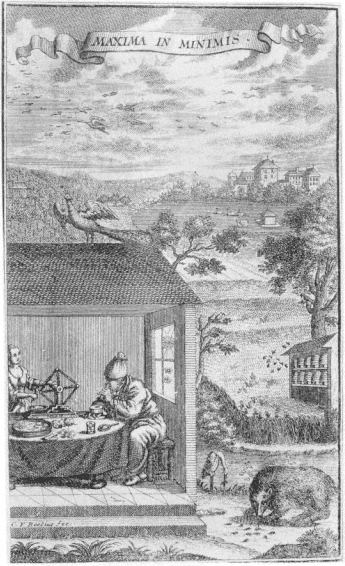
Fig. 1.1
Besides the strict mathematical method, which was intended only
for the learned reader, Wolff also used the physicotheological method
for a popular audience. According to the latter method, everything in
nature must be both perfect and useful. Demonstrating or proving
this thesis became a rationale for 18th-century natural history. The
scientist should look for "greatness in small things" (maxima in minimis),
which phrase served as the motto for Friedrich Christian Lesser's
Insectotheology (Frankfurt, 1740). The study of nature reveals the
infinite diligence of the wasps and the ants, the beauty and strange
development of the butterfly, the artfulness of the spider, the utility of the
silkworm—these and other features of nature provided inspiration
for 18th-century research and speculation.
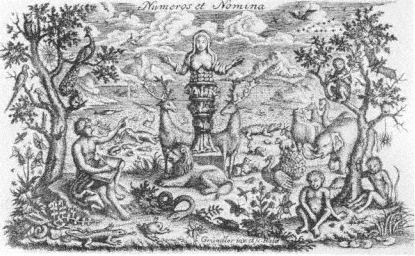
Fig. 1
Albrecht von Haller called Linnæus "the second Adam." He appears in this role
in a vignette for the eleventh edition of Systema naturae (ed. Lange, Haller, 1760). As
Adam, Linnæus is sitting naked, naming all the animals (cf. Genesis 2:19). Paradise is
crowded with animals and plants, monkeys climbing the trees, whales swimming in
the sea; everything is at peace. The fall is yet to come. The figure in the middle is Diana
polymammae, symbol of Nature and its generative force. Linnæus—with "his" flower
Linnea borealis at his feet—is urging numbers and names, Numeros et nomina,
from Diana. He is Nature's bookkeeper.
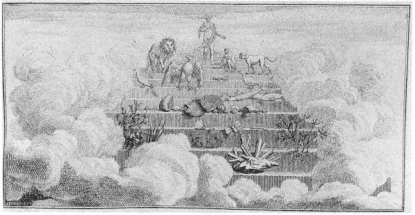
Fig. 2
This instructive vignette, from Charles Bonnet, Oeuvres d'histoire naturelle, 4
(Neufchâtel, 1781), depicts man at the top of the scale of nature. As man belongs
to both the material and the spiritual world, he keeps hishead in the clouds. On
lower steps of the scale follow the monkey, the lion and the dog, the eagle, fish,
lizards, corals, and so on. Everything in nature is thus to be understood
both in hierarchy and in continuity.
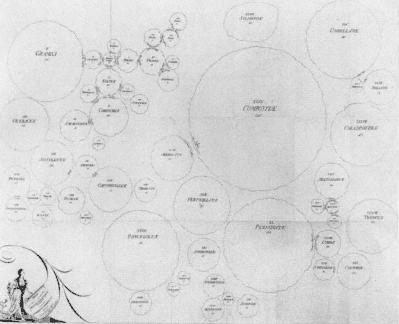
Fig. 3
In private lectures Linnæus discussed the possibility of arranging
natural orders linearly. With so many uncertainties in establishing these
orders and with so many more plants still to discover, however, such an
arrangement must wait. This map, believed to be based on a drawing by
Linnæus, shows continuity between some groups, as well as gaps requiring
more knowledge: Linnæus, Praelectiones in ordines naturales plantarum,
ed. P.D. Gieseke (Hamburg, 1792), facing p. 623.
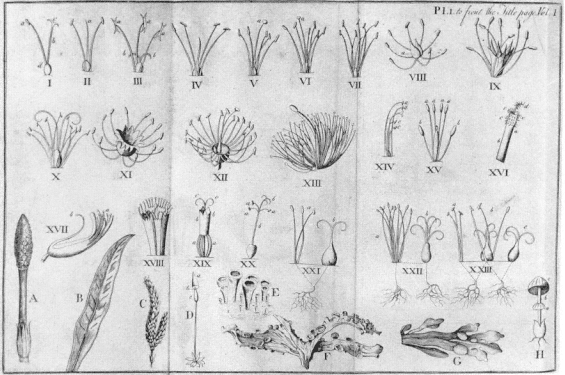
Fig. 3.1
Illustration of the Linnæan sexual system, from William Withering, A botanical arrangement
of all the vegetables growing in Great Britain (1776). See chapter 3, page 77.
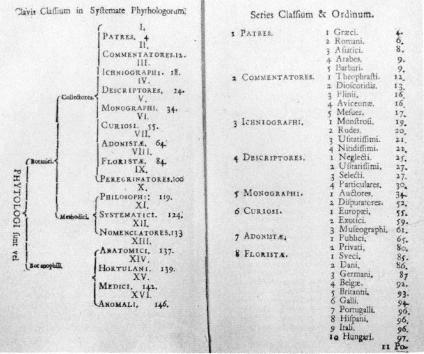
Fig. 3.2
Linnæus' classification of botanists, from his Bibliotheca
botanica (1736). See chapter 3, page 79.
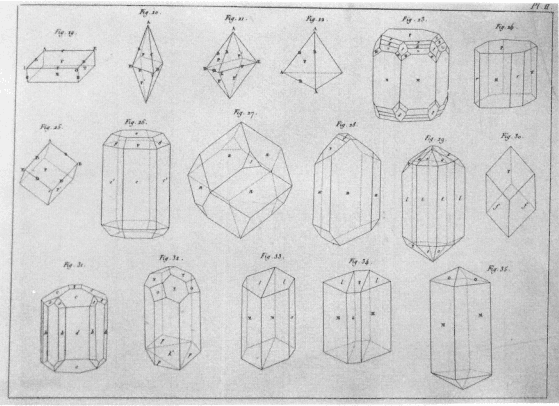
Fig. 3.3
René Just Haüy's geometrical forms of crystals, from his Tableau comparatif des résultats
de la cristallographie et de l'analyse chimique relativement à la classification des
minéraux (1809). See chapter 3, page 92.
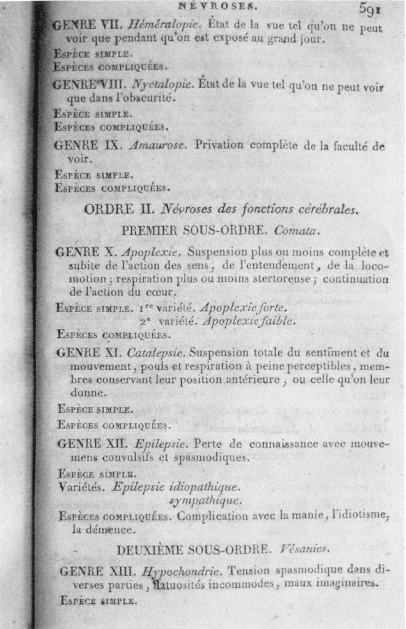
Fig. 3.4
Classification of nervous disorders showing orders, genera, species, and
varieties, from Philippe Pinel, Nosographie philosohique, 6th ed. (1818).
See chapter 3, page 99.
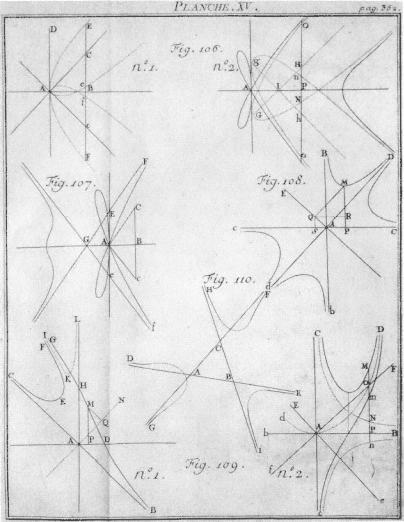
Fig. 3.5
Illustration of curves classified by Gabriel Cramer in his Introduction
à l'analyse des lignes courbes algébriques (1750). See chapter 3, page 102.
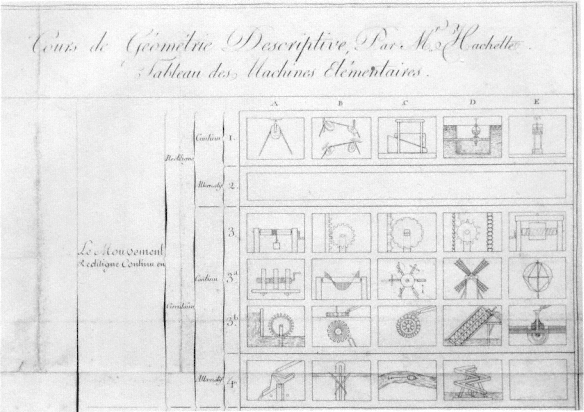
Fig. 3.6
Portion of Jean Nicolas Pierre Hachette's classification of simple machines, from
his Traité élémentaire des machines (1811). See chapter 3, page 106.
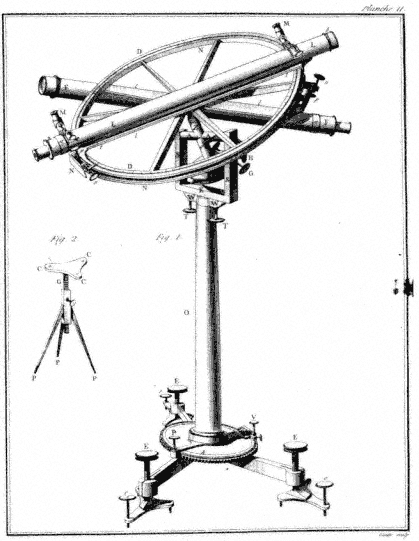
Fig. 6.1
The repeating circle, from Jacques Cassini, Pierre François Méchain, and
Adrien-Marie Legendre, Exposé des opérations faites en France [1791]. By
courtesy, National Land Survey (Lantmäteriverket), Gävle.
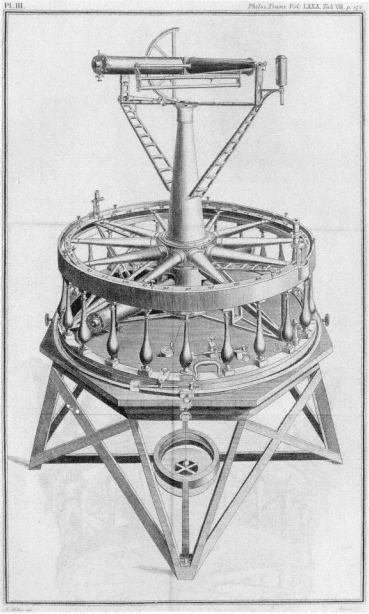
Fig. 6.2
According to William Roy, "It is a brass circle, three feet in diameter,
and may be called a theodolet [theodolite], rendered exremely perfect."
From Roy's "Account of the trigonometrical operation" in the
Philosophical transactions for 1790.
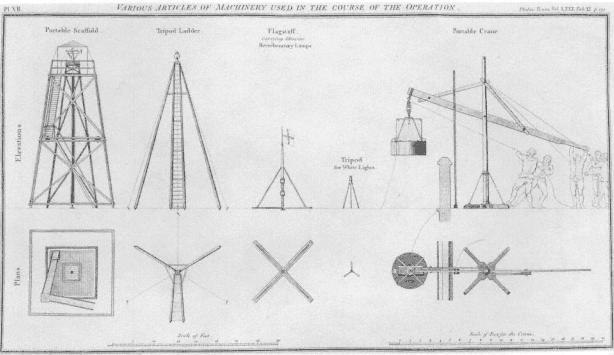
Fig. 6.3
The theodolite was used with a portable scaffold and crane in the high-tech military surveying
operations of the late 18th century. From Roy's "Account of the trigonometrical operation" (1790).
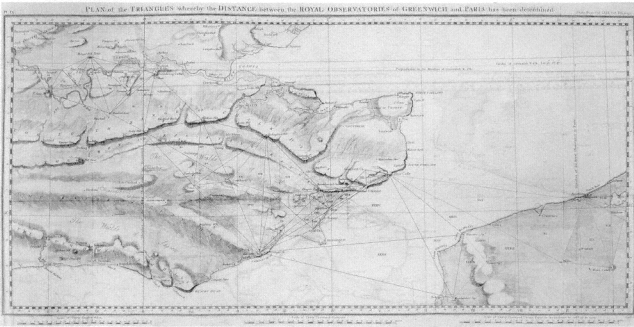
Fig. 6.4
The cross-channel connection, from Roy's "Account of the trigonometrical operation" (1790).
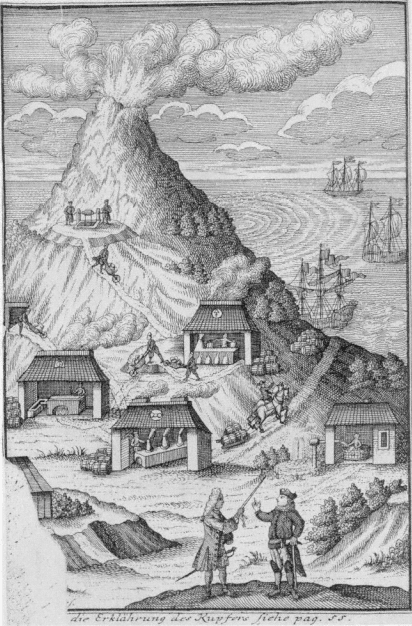
Fig. 8.1
The close connection between economics, technology, and chemistry in
"die ganze Historie vom Kiess," from F.J. Henckel, Pyrotologia (1725). Instruments
in the small buildings illustrate the role of chemistry in the production
of sulfur, vitriol, and arsenic from pyrites.
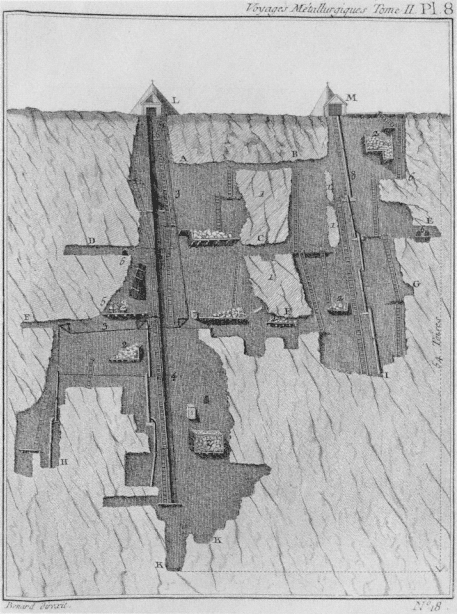
Fig. 8.2
Ädelfors mine in Sweden as seen in 1767 by G. Jars. From his Voyages métallurgiques, 2 (1780).
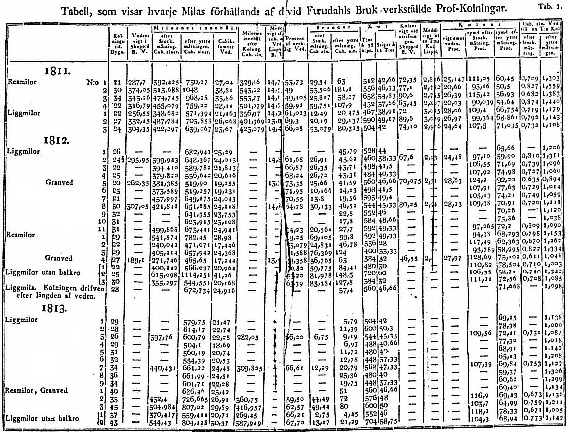
Fig. 10.1
Tabular display of experiments in charcoal-burning in Dalecarlia, from
Carl David af Uhr, Berättelse om kolnings-försök åren 1811, 1812 och 1813.
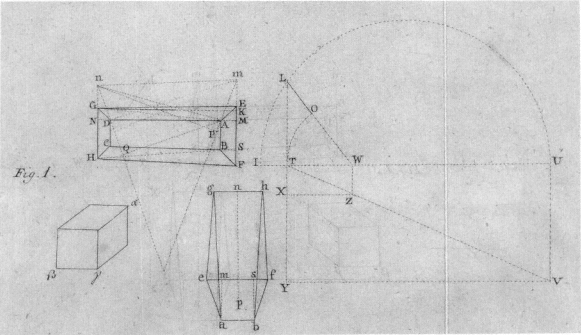
Fig. 10.2
Illustrations for Zacharias Plantin's studies of the volume of rhombic sledges of charcoal,
from the Kungl. Vetenskapsakademiens Handlingar for 1778 and 1784.
| ||||||||||||||||||||||||||||||||||||||||||||||||||||||||||||||||||||||||||||||||||||||||||||||||||||||||||||||||||||||||||||||||||||||||||||||||||||||||||||||||||||||||||||||||||||||||||||||||||||||||||||||||||||||||||||||||||||||||||||||||||||||||||||||||||||||||||||||||||||||||||||||||||||||||||||||||||||||||||||||||||||||||||||||||||||||||||||||||||||||||||||||||||||||||||||||||||||||||||||||||||||||||||||||||||||||||||||||||||||||||||||||||||||||||||||||||||||||||||||||||||||||||||||||||||||||||||||||||||||||
Fig. 10.3
Systematic display of data from Johann Eric Norberg's study (1772–3) of human muscle power,
from the Kungl. Vetenskapsakademiens Handlingar for 1799.
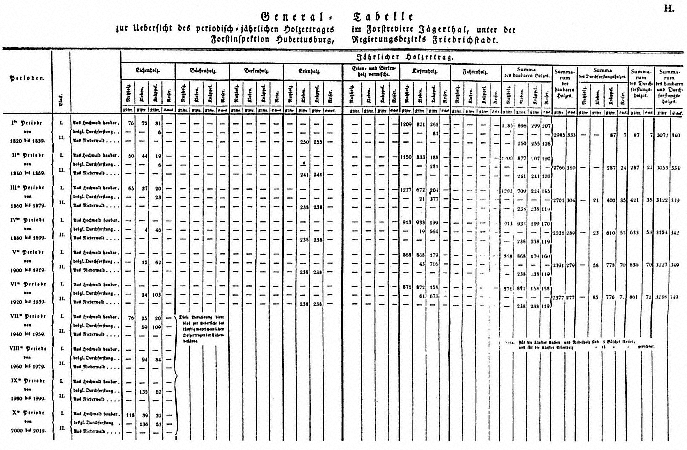
Fig. 11.1
Georg Hartig's 200-year plan for the Jägerthal forest district, from his Neue Instructionen (1819).
By courtesy, Department of Special Collections, Yale University.
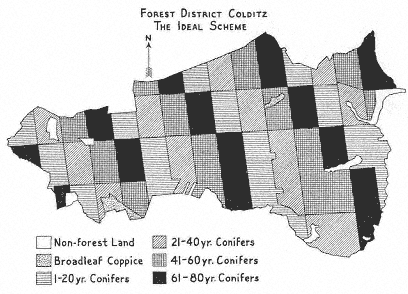
Fig. 11.2
Transformation of the Colditz forest district after 100 years of managements
according to Cotta's ideal scheme. From Heske, German forestry.
By courtesy, Stanford University Libraries.
